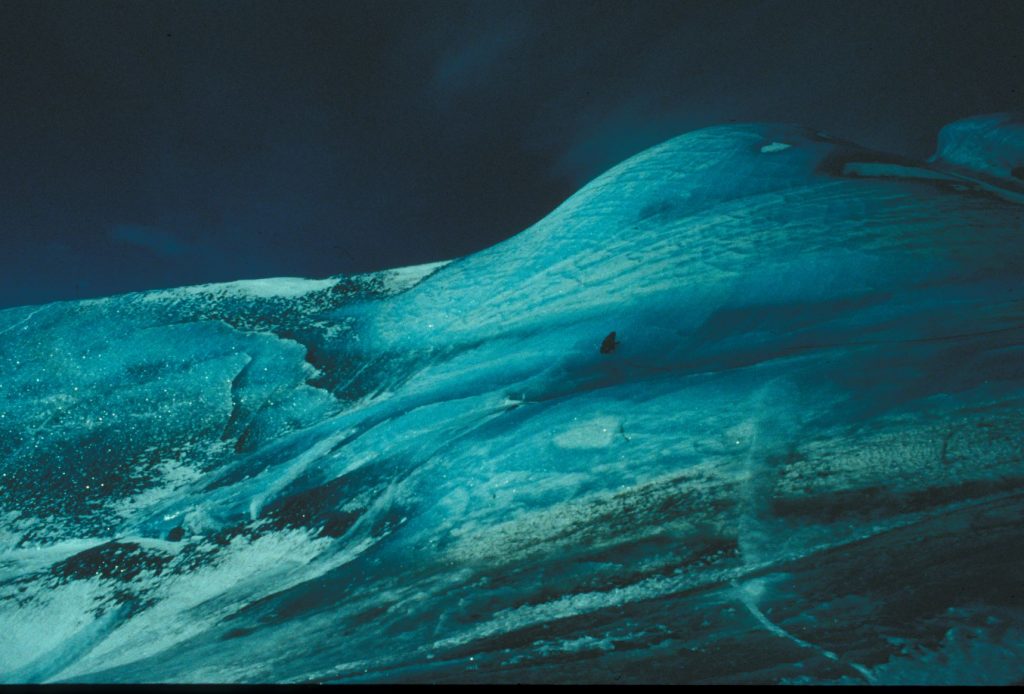Collin Roesler Gets Closer to Solving Mystery of Green Icebergs
By Rebecca GoldfineSince the early 1990s, explorers and sailors have caught sight of rare icebergs in parts of Antarctica that are a vivid emerald green. Scientists have long wondered why.
Most icebergs glow in shades of white and turquoise, aquamarine, or cobalt blue. Ice, when it is pure, looks blue because it absorbs more red light and reflects more blue light. So how to explain the odd green iceberg?
Bowdoin oceanographer Collin Roesler and a team of scientists have just published a paper in the Journal of Geophysical Research: Oceans that proposes a theory behind this color anomaly.
Their findings, though, go well beyond proposing a cool new hypothesis about color and light in ice—they could also deepen our understanding of how organisms like phytoplankton acquire critical, and rare, nutrients in the ocean.
Marine Ice versus Glacier Ice
One of the first distinctions the authors make in the paper is between the ice that makes up green and blue bergs. Glacier ice is formed from falling snow that builds up over time, solidifying and trapping air pockets that scatter light and give icebergs a cloudy blue-white appearance.
Marine ice, on the other hand, has a different consistency: it's clearer and darker, with no air bubbles. It is formed when seawater freezes to the underside of floating ice shelves, capturing, in a thick layer of ice, all the organic and inorganic material the ocean contains.
Icebergs, meanwhile, develop when big chunks of ice break off of massive ice shelves. Once the icebergs are free and bobbing at sea, they are at risk of capsizing. If such an unstable iceberg contains marine ice, it'll expose a jade underbelly when it flips over.

The paper's lead author, glaciologist Stephen Warren, Roesler, and other colleagues first proposed in the 1980s that the green icebergs were unique because they were made of marine ice. But they weren't sure why the ice was this color.
Warren shared his ideas with his students at the time, including Roesler. She offered to measure the absorption properties of the marine ice—work that resulted in a 1993 journal article. At the time, they presented the hypothesis that the icebergs were green due to the organic material frozen in the marine ice. But they eventually disproved this theory.
So the question lingered until they got a big clue from a 2016 report by an oceanographer from the University of Tasmania who found, to her surprise, that the marine ice at the bottom of an Antarctic ice core she was testing contained a large amount of iron.
This discovery has spurred Roesler, Warren, and coauthors Richard Brandt and Mark Curan to propose that the green icebergs they've been studying contain iron oxides from rock dust on Antarctica's mainland. As glaciers flow over bedrock on land, they grind rocks to a fine powder, or "glacial flour," that eventually flows into the sea. Some of this powder with iron oxides might get lodged in marine ice, turning it green.
But how? Just remember your color wheel! Iron oxides tend to be yellowish-red or orangey-brown—like rust. When combined with pure ice, the yellowish iron mixes with bluish ice, producing a greenish hue.
Meanwhile, iron is an important nutrient for phytoplankton, the microscopic organisms that form the base of the marine food web. "But iron is scarce in many areas of the ocean. If experiments prove the new theory right, it would mean green icebergs are ferrying precious iron from Antarctica’s mainland to the open sea," explains the American Geophysical Union, "providing this key nutrient to the organisms that support nearly all marine life."
“We always thought green icebergs were just an exotic curiosity," Warren added, "but now we think they may actually be important.”

After Roesler and her colleagues published their paper, a poet in the UK sent them a poem he wrote after being inspired by their findings. Read and listen to Fields of Green, by Samuel Illingworth.



